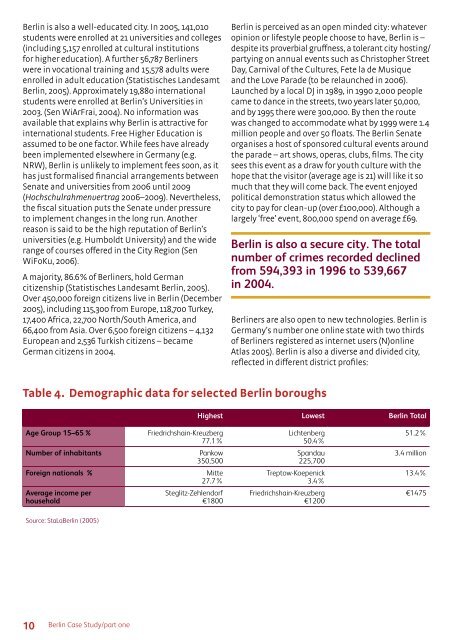Berlin Case Study - Cities Institute
Berlin Case Study - Cities Institute
Berlin Case Study - Cities Institute
You also want an ePaper? Increase the reach of your titles
YUMPU automatically turns print PDFs into web optimized ePapers that Google loves.
<strong>Berlin</strong> is also a well-educated city. In 2005, 141,010<br />
students were enrolled at 21 universities and colleges<br />
(including 5,157 enrolled at cultural institutions<br />
for higher education). A further 56,787 <strong>Berlin</strong>ers<br />
were in vocational training and 15,578 adults were<br />
enrolled in adult education (Statistisches Landesamt<br />
<strong>Berlin</strong>, 2005). Approximately 19,880 international<br />
students were enrolled at <strong>Berlin</strong>’s Universities in<br />
2003. (Sen WiArFrai, 2004). No information was<br />
available that explains why <strong>Berlin</strong> is attractive for<br />
international students. Free Higher Education is<br />
assumed to be one factor. While fees have already<br />
been implemented elsewhere in Germany (e.g.<br />
NRW), <strong>Berlin</strong> is unlikely to implement fees soon, as it<br />
has just formalised financial arrangements between<br />
Senate and universities from 2006 until 2009<br />
(Hochschulrahmenvertrag 2006–2009). Nevertheless,<br />
the fiscal situation puts the Senate under pressure<br />
to implement changes in the long run. Another<br />
reason is said to be the high reputation of <strong>Berlin</strong>’s<br />
universities (e.g. Humboldt University) and the wide<br />
range of courses offered in the City Region (Sen<br />
WiFoKu, 2006).<br />
A majority, 86.6% of <strong>Berlin</strong>ers, hold German<br />
citizenship (Statistisches Landesamt <strong>Berlin</strong>, 2005).<br />
Over 450,000 foreign citizens live in <strong>Berlin</strong> (December<br />
2005), including 115,300 from Europe, 118,700 Turkey,<br />
17,400 Africa, 22,700 North/South America, and<br />
66,400 from Asia. Over 6,500 foreign citizens – 4,132<br />
European and 2,536 Turkish citizens – became<br />
German citizens in 2004.<br />
<strong>Berlin</strong> is perceived as an open minded city: whatever<br />
opinion or lifestyle people choose to have, <strong>Berlin</strong> is –<br />
despite its proverbial gruffness, a tolerant city hosting/<br />
partying on annual events such as Christopher Street<br />
Day, Carnival of the Cultures, Fete la de Musique<br />
and the Love Parade (to be relaunched in 2006).<br />
Launched by a local DJ in 1989, in 1990 2,000 people<br />
came to dance in the streets, two years later 50,000,<br />
and by 1995 there were 300,000. By then the route<br />
was changed to accommodate what by 1999 were 1.4<br />
million people and over 50 floats. The <strong>Berlin</strong> Senate<br />
organises a host of sponsored cultural events around<br />
the parade – art shows, operas, clubs, films. The city<br />
sees this event as a draw for youth culture with the<br />
hope that the visitor (average age is 21) will like it so<br />
much that they will come back. The event enjoyed<br />
political demonstration status which allowed the<br />
city to pay for clean-up (over £100,000). Although a<br />
largely ‘free’ event, 800,000 spend on average £69.<br />
<strong>Berlin</strong> is also a secure city. The total<br />
number of crimes recorded declined<br />
from 594,393 in 1996 to 539,667<br />
in 2004.<br />
<strong>Berlin</strong>ers are also open to new technologies. <strong>Berlin</strong> is<br />
Germany’s number one online state with two thirds<br />
of <strong>Berlin</strong>ers registered as internet users (N)online<br />
Atlas 2005). <strong>Berlin</strong> is also a diverse and divided city,<br />
reflected in different district profiles:<br />
Table 4. Demographic data for selected <strong>Berlin</strong> boroughs<br />
Highest Lowest <strong>Berlin</strong> Total<br />
Age Group 15–65 %<br />
Number of inhabitants<br />
Foreign nationals %<br />
Average income per<br />
household<br />
Friedrichshain-Kreuzberg<br />
77.1%<br />
Pankow<br />
350,500<br />
Mitte<br />
27.7%<br />
Steglitz-Zehlendorf<br />
€1800<br />
Lichtenberg<br />
50.4%<br />
Spandau<br />
225,700<br />
Treptow-Koepenick<br />
3.4%<br />
Friedrichshain-Kreuzberg<br />
€1200<br />
51.2%<br />
3.4 million<br />
13.4%<br />
€1475<br />
Source: StaLa<strong>Berlin</strong> (2005)<br />
10<br />
<strong>Berlin</strong> <strong>Case</strong> <strong>Study</strong>/part one




